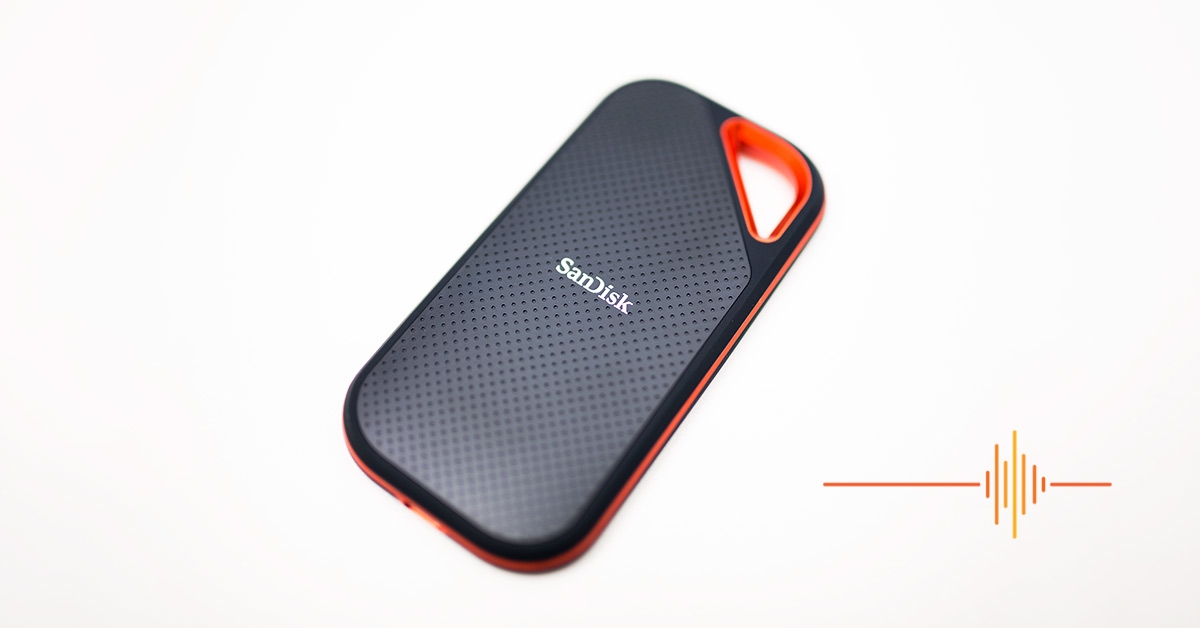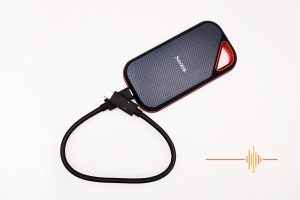 The new generation of SanDisk Extreme Pro Portable SSD utilises NVMe technology with the drive providing both (uh, no other way to put this) extreme speed and reasonable storage sizes of 1TB and 2TB. The latest generation of the SanDisk Extreme Pro drive makes full use of Gen 2×2 technology and provides insane speeds. While it is marketed for photographers and videographers, it proves that great things come in small packages and the external drive is beyond perfect for anyone that wants reliable and fast storage on the go.
The new generation of SanDisk Extreme Pro Portable SSD utilises NVMe technology with the drive providing both (uh, no other way to put this) extreme speed and reasonable storage sizes of 1TB and 2TB. The latest generation of the SanDisk Extreme Pro drive makes full use of Gen 2×2 technology and provides insane speeds. While it is marketed for photographers and videographers, it proves that great things come in small packages and the external drive is beyond perfect for anyone that wants reliable and fast storage on the go.
Out of the box, the drive is small, compact, and feels rock solid. Through testing, it has proven to deliver at exceptionally high levels and will provide you ultimate performance… if your computer can keep up.
Yes, in this age, we are getting to a point where storage space is not simply enough. You need space AND you need speed. And the more of both, the better. With that said, is it worth it? When does it become, well, too much? In reviewing the SanDisk Extreme Pro Portable SSD 2TB drive, I’m going to have a look at that very question.
The Physical Drive – Velvety Smooth, But Tough
Have you ever picked up an external drive and it felt flimsy in the hand? Like you can’t squeeze it too hard for fear of pressing against the plate or if you hold it the wrong way it might bend or break something inside? Any hard drive with a plastic enclosure, I always have this fear. Maybe I’m odd. But I just feel like I’m going to break so many of my external drives, especially if I knock it the wrong way or drop if from my desk.
That is definitely not the case here with the SanDisk Extreme Pro Portable SSD. At about 10mm thick, 57mm wide (i.e. the width of a credit card) and 110mm long (about 1.25x the length of a credit card) it fits nicely in the hand. It has a reasonable weight to it (at about 80grams), a lack of flex, and the feel of great build quality. It just feels like it will bounce (and more on that in a second).
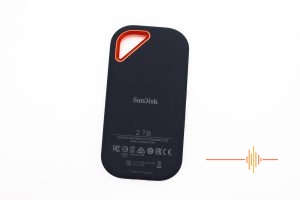 From a pure aesthetics point of view, the drive is slick and classy. Predominantly with a matte grey appearance, it features a striking and stunning orange metal surround. (We here at Digital Reviews Network really like orange, but more on that next year! Editor’s note: It’s next year. I think we know why we like orange now!) The orange comes from a forged aluminium core that adds durability but also aids with heat dissipation. Wrapped in silicon and featuring a tough ABS cover on top, the drive feels velvety (though does pick up some dust) and seems like it is built to take anything you throw at it.
From a pure aesthetics point of view, the drive is slick and classy. Predominantly with a matte grey appearance, it features a striking and stunning orange metal surround. (We here at Digital Reviews Network really like orange, but more on that next year! Editor’s note: It’s next year. I think we know why we like orange now!) The orange comes from a forged aluminium core that adds durability but also aids with heat dissipation. Wrapped in silicon and featuring a tough ABS cover on top, the drive feels velvety (though does pick up some dust) and seems like it is built to take anything you throw at it.
Being built to be a working photographer and videographer’s portable storage option, SanDisk have had to ensure this this portable SSD can take what a working photographer would throw at it… and having been one in the past, and having worked with plenty, I can tell you that that means it needs to handle being dropped from camera bags, be amongst sand, dirt, rain, fire, and who knows what else. This drive feels like it can take it, and is rugged, solid, and ready to be thrown about in a camera bag. And with a USB Type-C connector in addition to that forged aluminium core, silicon wrap and ABS cover, it is advertised to be IP55 water and dust resistant with 2metre drop resistance. (Sorry, not advertised as fire resistant!)
Now, did I test this 2 metre drop resistance? Freely admitting that, no, I did not. I do not think SanDisk would have appreciated me sending back a scuffed and chipped unit. But I did give it a couple of decent taps with my fingers and, being an NVMe SSD drive with no noticeable moving parts inside (farewell hard disk drive spinning platter), it just feels like it could take a beating.
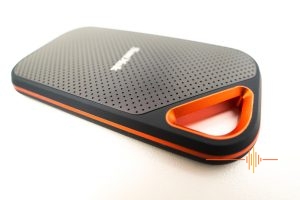 The other striking feature of this drive is the angular hole in the top of the drive. Again, sporting the gorgeous orange aluminium within, the hole acts as a handy carbineer loop. As someone who goes out in the field with a bag full of gear, the ability to throw a clip or tie on the drive and secure it in (or on) a bag, reducing the fear of it flying out the bag when opened, is nothing but a win.
The other striking feature of this drive is the angular hole in the top of the drive. Again, sporting the gorgeous orange aluminium within, the hole acts as a handy carbineer loop. As someone who goes out in the field with a bag full of gear, the ability to throw a clip or tie on the drive and secure it in (or on) a bag, reducing the fear of it flying out the bag when opened, is nothing but a win.
A final note on the build is that the silicon wrap adds a very handy grip to the desk surface to prevent slipping or sliding. Even though it would bounce with that 2 metre drop resistance, it won’t go flying across the desk if I knock it.
What do you need to get the most?
Before we get into my test results, let’s have a look at some technical requirements. And this is where it will get confusing (thanks USB naming conventions) and a touch difficult. But it will also perhaps help you decide whether upgrading to an external USB SSD storage drive is really worth it. Because, yes, depending on your current computing gear, this drive may not be for you.
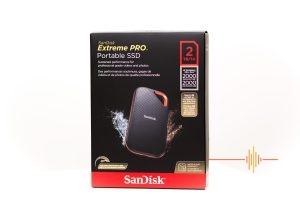 Two things come into play with getting the very best out of this drive.
Two things come into play with getting the very best out of this drive.
1) The kind of USB ports you have available to you.
2) The read/write speeds of other drives if you are transferring files around from them.
Your USB ports have a massive impact on the performance of this drive. If you are rolling USB 2.0 (please upgrade), the speed of the drive is going to be severely inhibited by what your hardware will allow (about 480Mbps). Similarly, USB 3.2 Gen 1 (formerly USB 3.0) will deliver a maximum of 5 Gbps and USB 3.2 Gen 2 (formerly USB 3.1) will deliver approximately 10 Gbps. What you really want here is USB 3.2 Gen 2×2 — this will have the SanDisk Extreme Pro Portable SSD absolutely flying with up to 20 Gbps.
Well, if you have the internal drives to keep up.
Because if you are transferring files around between drives, you will need suitable hardware to keep up with the SanDisk Extreme Pro Portable SSD. With reference to read/write speeds of drives, it’s quite simple. While this drive can read/write at stupidly high speeds, if you are transferring files around from an old internal hard disk drives that do not have high transfer rates, your SanDisk Extreme Pro Portable SSD is going to be throttled back. If you are bouncing files from an internal SSD, that will perform better. If you’re working off an NVMe m.2 SSD drive, that will have optimal results.
Personally, in my current build (a slightly older PC which is patiently waiting for a new companion), I am running a series of SATA SSDs and HDDs inside the box. For connectivity, I have a Gigabyte USB 3.2 Gen2x2 Expansion Card. This card boosts speeds up to 20 Gbs for compatible devices. This does mean I get the best performance while working off the SanDisk drive
The Tests
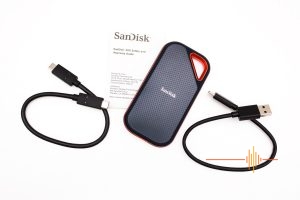 I ran a series of every day tests comparing the SanDisk Extreme Pro Portable SSD against two Seagate USB portable HDDs and, to make it fair, a WD_Black P50 Game Drive SSD.
I ran a series of every day tests comparing the SanDisk Extreme Pro Portable SSD against two Seagate USB portable HDDs and, to make it fair, a WD_Black P50 Game Drive SSD.
My initial tests, as always, are some simple transfers. Yes, the drive is built for photographers and videographers, but good to just get a simple benchmark.
Test One – Worth A Thousand Words
I copied over a folder with a thousand Word documents, each Word document 20.5kb in size. The folder was copied from my desktop (with files on an internal SSD) to each drive. For each test, I have identified the type of USB port that I am using.
2TB Seagate Expansion Drive (USB 3.2 Gen 2 10Gbps): 4.46 seconds
Seagate Backup Plus (USB 3.2 Gen 2 10Gbps): 5.62 seconds
WD _Black P50 SSD (USB 3.2 Gen 2 10Gbps): 3.92 seconds
SanDisk Extreme Pro SSD (USB 3.2 Gen 2 10Gbps): 4.16 seconds
WD_Black P50 SSD (USB 3.2 Gen 2×2 20Gbps): 3.56 seconds
SanDisk Extreme Pro SSD (USB 3.2 Gen 2×2 20Gbps): 3.67 seconds
In these tests, the WD_Black P50 SSD does come out on top. But, well, look at the timings? Counting for user error for timing, it is miniscule. But, a thousand little files isn’t where this drive will shine. Next test!
Test Two – The Bigger Fall Harder
My next standard test is transferring a 5gb file from my desktop onto the drive. Large files will always transfer faster than lots of little.
2TB Seagate Expansion Drive (USB 3.2 Gen 2 10Gbps): 41.97 seconds
Seagate Backup Plus (USB 3.2 Gen 2 10Gbps): 46.04 seconds
WD _Black P50 SSD (USB 3.2 Gen 2 10Gbps): 16.43 seconds
SanDisk Extreme Pro SSD (USB 3.2 Gen 2 10Gbps): 15.66 seconds
WD_Black P50 SSD (USB 3.2 Gen 2×2 20Gbps): 6.16 seconds
SanDisk Extreme Pro SSD (USB 3.2 Gen 2×2 20Gbps): 6.12 seconds
The SanDisk Extreme Pro Portable SSD comes out on top here, fractionally using USB 3.2 Gen 2×2, but still a clear winner on repeated tests. What is noticeable here is the speed difference between the HDDs and SSD drives. THIS is why you pay extra for an Portable SSD. Even using standard USB 3.2 Gen 2 ports, the drive delivers superfast speeds.
Test Three / Four – Photo and Video Transfers
For a drive built for photographers, it only makes sense that I test the drive for a variety of photography related tasks. Then copying of a large video file resulted in similar speeds across all drives and both USB ports (approximately 50 seconds). The reason for this? My hardware.
Similarly, I copied over a folder of photos from a recent photoshoot with one of Australia’s top marketing directors. The folder contains 219 raw photos, a dozen XMP files, and 48 JPG exports from Lightroom. This totalled 5.6gb with a variety of file sizes. Now, again, this test is skewed by the type of drive my storage drive is (more on that in a second), but these results are still worth showing.
2TB Seagate Expansion Drive (USB 3.2 Gen 2 10Gbps): 53.45 seconds
Seagate Backup Plus (USB 3.2 Gen 2 10Gbps): 1 minute, 4.76 seconds
WD _Black P50 SSD (USB 3.2 Gen 2 10Gbps): 40.11 seconds
SanDisk Extreme Pro SSD (USB 3.2 Gen 2 10Gbps): 39.87 seconds
WD_Black P50 SSD (USB 3.2 Gen 2×2 20Gbps): 39.98 seconds
SanDisk Extreme Pro SSD (USB 3.2 Gen 2×2 20Gbps): 39.70 seconds
Now, I will note that those speeds between the two USB ports on my computer aren’t much different. And that is a clear demonstration of how the hardware in my computer impacts the performance of this drive. That same test run with the files stored on the SSD drive in my computer sees the transfer of these 279 files complete in less than 14 seconds. And, if I had an m.2 SSD drive I was transferring the files from, I’d hazard a guess that it would be complete in about 5 seconds. However, it does show that the SSD still out performs the portable HDDs (as one would expect).
The Final Test – The Photographer’s Drive
 My final test was simply opening a RAW CR2 photograph from each drive in Photoshop. Now, these timings were done a number of times and averaged out, but results were consistent.
My final test was simply opening a RAW CR2 photograph from each drive in Photoshop. Now, these timings were done a number of times and averaged out, but results were consistent.
2TB Seagate Expansion Drive (USB 3.2 Gen 2 10Gbps): 2.87seconds
Seagate Backup Plus (USB 3.2 Gen 2 10Gbps): 3.12 seconds
WD _Black P50 SSD (USB 3.2 Gen 2 10Gbps): 1.76 seconds
SanDisk Extreme Pro SSD (USB 3.2 Gen 2 10Gbps): 1.65 seconds
WD_Black P50 SSD (USB 3.2 Gen 2×2 20Gbps): 1.30 seconds
SanDisk Extreme Pro SSD (USB 3.2 Gen 2×2 20Gbps): 1.35 seconds
Yes, the SanDisk Extreme Pro Portable SSD (and WD_Black P50) performs incredibly well here. It is lightning fast. In fact, the same task done on my storage drive (where I normally work from) was clocking in over 3 seconds. When I was a working photographer, some shoots (hello weddings!) have 100s of photographs to edit. A couple of seconds each time can add up.
In fact, working FROM the drive was a pleasure. Importing photos into Lightroom was quick and painless. Opening files in Photoshop was quick. Response times were snappy. Saving was seamless. Overall, working from the drive was a pleasure. I even stored some video on it and opened and played around in Final Cut and exported, and found performance was significantly better than running on my computer. As a working drive alone, this drive is impressive, never mind the potential transfer speeds.
Some added security
Just a brief note that the SanDisk Extreme Pro Portable SSD comes with included password protection featuring 256 bit AES hardware encryption with SanDisk’s Secure Access software. This comes readily available on the drive. I did not install it so can’t comment on it, but in a day and age where security of files are critical, especially if you’re a photographer working in the field with your working library in your bag, I can’t help but feel this is a good addition.
The drive also comes with a five year limited warranty, too, which helps add a whole lot of reassurance that you can rely on the SanDisk Extreme Pro Portable SSD.
Conclusions
So, the drive performs as you would expect. It’s an SSD, so it is already going to perform better than external HDDs. But with USB 3.2 Gen 2×2, this drive will perform better than your internal drives unless you’re running on the latest hardware m.2 SSD drives.
So, IS it worth it?
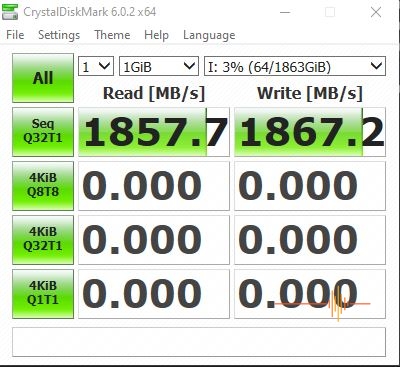 It all comes down to how you will use it and what hardware you yourself are using. I won’t tell you to go buy this drive as a portable drive to store a year 11 history essay or to throw your holiday snaps on to show off to your grandma on her TV. But if you deal with large media often, if you need to store and work from an external drive (hello laptop users with small drives!) and you have relatively new technology (and especially if you have a USB 3.2 Gen 2×2 USB port available to you on your motherboard or via an expansion card), this drive will perform beyond expectations for you.
It all comes down to how you will use it and what hardware you yourself are using. I won’t tell you to go buy this drive as a portable drive to store a year 11 history essay or to throw your holiday snaps on to show off to your grandma on her TV. But if you deal with large media often, if you need to store and work from an external drive (hello laptop users with small drives!) and you have relatively new technology (and especially if you have a USB 3.2 Gen 2×2 USB port available to you on your motherboard or via an expansion card), this drive will perform beyond expectations for you.
For photographers who work in the field and want that reliability of a drive with no moving parts, which is drop resistant and water and dust resistant, well, yes, this drive is definitely a game changer. I would not hesitate to throw this drive in my camera bag. Probably literally throw, because this drive will take that treatment.
But, it does come at a price point that is not for the casual user. Priced from $400 to $725 depending on the 1TB or 2TB model, and knowing how photographers love to spend on top quality gear, it is understandable why they are the target audience.
My only final word is this: If I was still a working photographer, shooting and editing in the field a lot, with the money to spare, would I go grab a SanDisk Extreme Pro Portable SSD USB 3.2 Gen 2×2?
Yes.
***
Thank you SanDisk for sending out a loaner for DRN to review (and, yes, I am sad to be sending it back!). SanDisk Extreme Pro drives can be purchased from Amazon. If you are interested, please visit via our link, which will allow DRN to receive a small commission.


